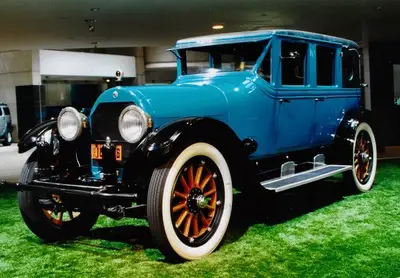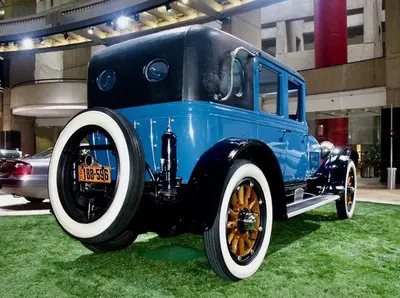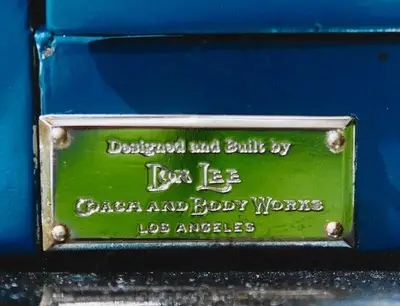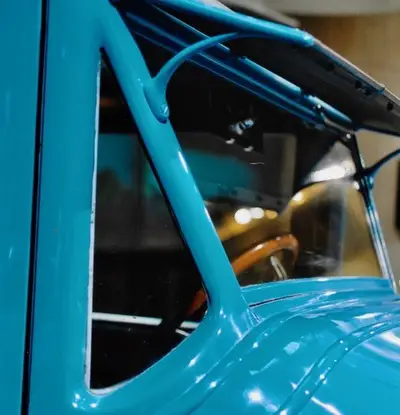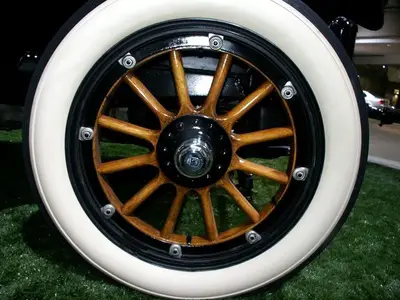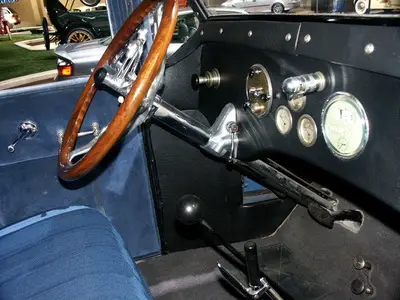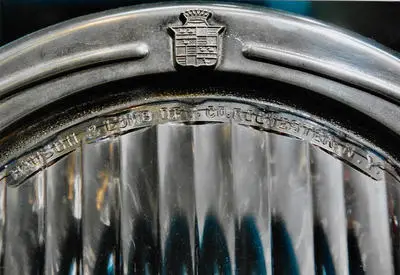HARLEY EARL’S ONE-OFF 1920 CADILLAC LIMO
Reporting and Photography
By Steve Purdy
Shunpiker Productions
Updated 6/30/2020
Originally posted on TheAutoChannel 1/30/2005
Detroit We often wonder whether the corporate cultures of our Detroit automakers pay enough attention to their own history. General Motors abandoned its historic 1930s Albert Kahn-designed headquarters building in the New Center area of Detroit in favor of the dramatic towers of the downtown Renaissance Center nearly two decades ago. We were saddened a decade earlier when GM closed the Cadillac Museum at the old factory on Clark Street in Detroit moving the whole collection to a warehouse near the Tech Center in Troy. Only the specially invited were allowed in. It was there at the warehouse that I first saw the Harley Earl Cadillac Limousine featured here.
Friend and fellow journalist, Gary Witzenburg, was producing an extensive feature on the history of Cadillac design and the GM folks had just acquired this unique 1920 Limo. He asked me to photograph the car to compliment his article.
It was Friday afternoon of July 4th weekend. Greg Wallace, Cadillac Collection director, and his staff were ready to get out of there; in fact, they were chomping at the bit. We had to push the car out of the building into the hot summer sunshine and around front of the facility before we could get a good photographic background. It was worth the sweat as it turned out to be an exceptionally photogenic old car.
What’s so unique and interesting about this Cadillac Limo, you ask? Well, in addition to a raft of unusual features, it was designed and built as a one-off custom-bodied car by the legendary Harley Earl nearly 7 years before he went to work for GM, where he later became one of the first and probably the most significant American automobile “designer” of the 20th century.
Born in 1893, Harley Earl grew up in Hollywood. His father, Jacob W. Earl, owned the very successful coach building business known as the Earl Automobile Works where they built custom-bodied cars for wealthy clients. Young Harley was interested in the family business from an early age and worked with his father throughout high school and college. He had the Hollywood style and panache but not the arrogance or sloth that often came with being surrounded by such ostentation. After finishing college at Stanford where he studied engineering, art and anatomy he went to work full time for the Earl Automobile Works. It is unclear whether he actually graduated with a degree from Stanford but that question is certainly irrelevant in light of his later accomplishments.
In a 1956 interview Earl described his early role at his father’s company.
“You see, it was the Earl Carriage Works,” he said. “My father had a carriage factory out there with about 500 bodybuilders and painters and, you know, the people that go with that enterprise. And then, after the war – World War One – I started in that business, and he retired, and I took it over and ran it for a very short time, and then we had an opportunity . . . for about six months, my dad was a little sick, and he went away, and I put it, the carriage business, into the motorcar business; started selling bodies, interesting ones for the movies.”
One-off custom-bodied luxury cars were the bread and butter of the Earl Automobile Works and Harley had the talent, style and instinct to make customers very happy. In 1919 the company was sold to the west coast’s most successful Cadillac dealer, Don Lee of Los Angeles. Seeing that Earl had the talent, drive and finesse for the business of making cars for the stars, Lee kept young “Hollywood” Harley Earl on as manager of the company. In fact, part of the purchase agreement was that Harley Earl would stay on and run it.
Earl talked about those early days of the Don Lee ownership.
“It didn’t take long, “he said, “we were turning out about 300 car bodies a year, custom bodies, and shipping some to India and Europe.” One of his first major projects for the Don Lee business was to design and build a car for movie star Fatty Arbuckle that became one of the most expensive cars ever built up until that time at around $28,000. This and similar high-profile projects kept the names Harley Earl and Don Lee at the top of the list for money-is-no-object automobile customers.
In succeeding years, it was not unusual for the Detroit Cadillac plant to ship a hundred chassis at a time to the Don Lee Coach and Body Works. Business was brisk. Their reputation as the premier custom car builder continued to grow, and Harley Earl was running the show like a showman. He had a talent not only for the aesthetics of car design but for the promotion of the business as well. It is likely he learned some of these skills from the film stars for whom he built cars. These talents would result in his being recruited a few years later by Fred Fisher to design the new LaSalle automobile and ultimately to be GM’s first design chief.
We could spend another ten pages talking about Earl’s accomplishments at GM but we haven’t the space. Sorry.
This particular car was built for John and Beatrice Rohan of Oakland, California. Rohan was a colorful merchant, politician and philanthropist “whose life reads like a Horatio Alger story,” according to his obituary in the Oakland Tribune. Born in Kansas in 1869 he came to San Francisco as a young man and made a living shoveling coal. He made a wager with his boss that if he could work in the coal yard without pay for 2 full years he would be given half interest in the firm. Both met their respective ends of the bargain and Rohan parlayed that business into many other successful enterprises.
The general state of the post WWI automobile market in 1920 was characterized by a lack of materials, frequent railroad strikes – a generally soft economy. These factors, combined with the logistical issues surrounding a new factory, resulted in a production slump at Cadillac in 1920 and ’21. The resounding success of the Type 57 in its war role carried over to generate great demand for the Type-59.
Being a man of considerable means Mr. Rohan, like many of his contemporaries, went to the Earl Automobile Works which had just become the Don Lee Coach and Body Works, to purchase an automobile that would reflect his success. At the Don Lee Cadillac dealership in 1920 there were seven Cadillac models to choose from: three open cars (a touring car, a phaeton and a roadster) and 4 closed cars (a Victoria, a sedan, and two limos – regular and Imperial). None quite fit the bill for Mr. Rohan. He needed something with a bit more exclusivity. This special Harley Earl-designed 1920 Cadillac Type 59 is the automobile that fit the bill. It exemplifies the finesse with which Harley Earl executed this and other special automobiles.
This lovely blue limo features a body similar in overall shape to the factory-built Cadillac limo but with more elegant details. Most distinctive are the triangular windshield extensions hinting at the wrap-around windshield that would be common many years later. The all-aluminum custom body features a leather-covered roof with dual vents, windshield visor, oval-shaped beveled glass opera side windows and two beveled oval rear windows as well. Dressy running boards and kick plates at each door punctuate the lower body.
The underpinnings of the Harley Earl Limo are standard 1920 Cadillac, as far as we can tell, with 132-inch wheelbase. The L-head, cast iron, 90-degree V-8 engine was first available in 1915. Cast in two four-cylinder halves, the engine displaces 314 cubic inches and develops 70 horsepower. It has a chain-driven cam, a gear-driven oil pump, tungsten steel valves and an accessory tire pump mounted within the ‘V.’ The factory brochure brags about the 3-bearing crank and connecting rod bearings being of “liberal dimensions.” A peek under the rear reveals dual exhausts.
Jewelry-like door handles and window cranks set off the luxurious interior along with a beautiful wood “collapsible” steering wheel. We would call it a tilt steering wheel today. A lever on the steering column tilts the Bosch and Lomb headlights to aim them where ever the driver wants - down to see the road close by or up to see 300 feet down the road.
How much do you suppose Mr. And Mrs. Rohan paid for this beautiful limo? Not as much as Fatty Arbuckle paid for his, to be sure. But the sum was still regal at $8,100.00. The check was signed by Beatrice L. Rohan on July 20, 1920 and drawn on the Oakland Branch of the Bank of Italy.
When Mr. Rohan died in 1926 at age 57 his widow kept the car. She died in 1946 leaving the car to their children. The car’s history becomes a bit vague at that point until it is purchased at the Mennonite Relief Sale by real estate developer William Goertzen of Shafter, California for $34,000. Mr. Goertzen then donated the car to Fresno Pacific College where their daughter and granddaughter studied. The GM folks acquired the car through a private sale in the summer of 2002.
This historic Harley Earl Cadillac takes it’s turn on display at shows and in the large display space at the GM Renaissance Center Headquarters along the river in downtown Detroit where. guests enter through the bright and airy solarium facing south overlooking the Detroit River. A variety of GM products, old and new, are on display throughout the ground floor. Sometimes one of these will be the 1920 Harley Earl Cadillac Limousine.
GM’s Cadillac collection is now housed in an even larger warehouse along with collections from the other divisions and shelves and shelves of archives. The GM Heritage Center is the repository of corporate history and is still accessible only upon invitation.
This unusual car represents an early stage of “Hollywood” Harley Earl’s development as a designer of forward-looking automobiles. He was only 27-years-old when he created this car. Having emerged from a privileged background in the custom automobile business he distinguished himself over and over again throughout his career with General Motors. He invented “bling-bling” according to his biographer and grandson Richard Earl who maintains an extensive website dedicated to his grandfather. What is even more remarkable according to the younger Mr. Earl is that his grandfather, though certainly a flashy fellow always in the limelight, did not seek that attention or become arrogant or jaded. He always sought to share the credit for his successes with those around him.
Buick commercials a few years ago featured the ghost of Harley Earl as spokesman claiming that GM is paying attention to its rich history. Though stretched considerably by artistic license the advertising folks have portrayed GMs respect for company heritage and particularly for their most important design chief, “Hollywood” Harley Earl.
Check out the fascinating Harley Earl Website at www.carofthecentury.com



